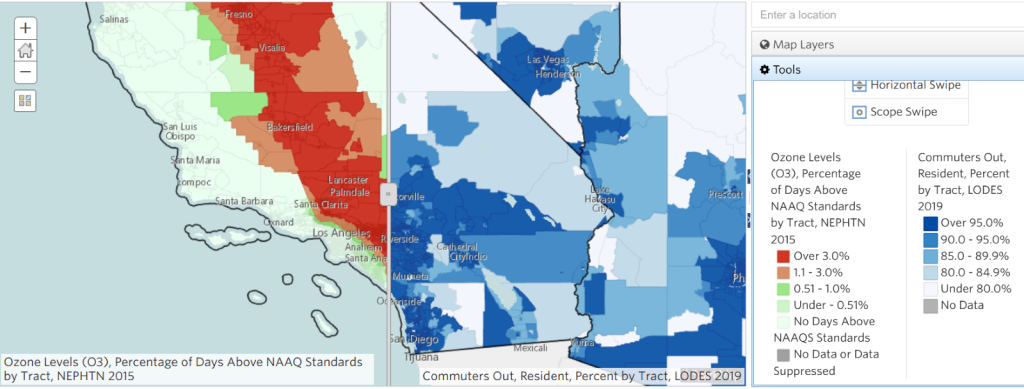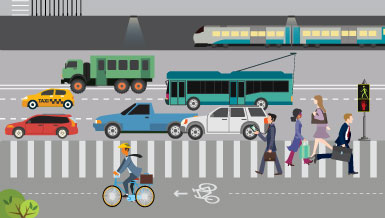The Health, Environmental, and Economic Impacts of Commuting
There are many things you can do in 27 minutes. You can get in a yoga session, go for a walk with the family around the neighborhood, read a couple of chapters in a book, or catch up on your favorite show. Instead, the average American spends 27 minutes just traveling to work, one way. Nearly an hour a day is spent traveling and if you take public transportation then that time is increased by 78%[1]!
The average length of commuting has increased in recent years, despite a growth in the number of jobs in suburban areas[2]. In our analysis of the 2019 Census Origin-Destination dataset, 44% of people who lived in metro counties, as defined by the USDA, commuted to work outside of their home counties. In non-metro counties that number was 54%. Long commutes can not only impact the mental and physical well-being of individuals but commuting also affects air quality and contributes to the pollution of waterways. Additionally, local economies are greatly impacted by people commuting in or out of an area.
Commuting and Your Health
There is some nuance when talking about the health impacts of commuting, as not all modes of commuting are created equal. People who regularly walk or bike to work are likely to experience a net positive impact of commuting on their physical and mental well-being. However, less than 4% of workers walk or bike to work nation-wide[3]. Most commuters take modes of transportation that involve a lot of sitting. If you drive to work, you may also be exposed to additional sources of stress on the road that those who take other modes of transportation are not exposed to. People who commute are more likely than their non-commuting counterparts to be overweight and have high blood pressure which are high risk indicators of heart disease, diabetes, and some cancers[4].

Beyond individual risks, commuting contributes to an increase in air, water, and noise pollution that affects residents of an area as well as the local ecological communities. Emissions from vehicles that directly negatively impact human health include carbon dioxide, methane, particulate matter, and nitrogen oxides, which can cause cardiovascular disease or respiratory issues [5]. Additionally, oil, gasoline, brake fluid, dirt, and other pollutants can runoff the roadways into water systems and affect drinking water supplies, water used for irrigation, and wetlands which impact human and environmental health[6].

Commuting and the Economy
Commuting not only impacts individual and environmental well-being, but it also influences where and how money is spent within a local economy through tax revenue, business locations, and individual spending patterns. Suburbs may see an increase in property tax revenue as they gain residents. However, if they have a high out-commute rate, sales tax revenue that may otherwise be spent in their region goes elsewhere as people travel to other areas for work. Businesses that are looking for areas in which to locate need to consider land use, local infrastructure and taxes, and of course, the workforce. Places with highly efficient commutes are often more profitable for businesses[7]. Commuting also impacts the economic well-being of individuals as they must balance the cost of the commute with the cost of living in their area and their salary. Long commutes for low-income workers directly affect their ability to get out of poverty, and also negatively impacts the whole economy which rely on these workers [8].
Using SparkMap for Commuting Data
You can find data from the U.S. Census Bureau regarding commuting in the American Community Survey and Location-Origin Dataset on SparkMap. You can also find many of the datasets mentioned in this blog such as obesity, heart disease, pollution, and others.
Sources
- https://nationalequityatlas.org/indicators/Commute_time#/?tranmode01=2
- https://www.bloomberg.com/news/articles/2019-12-09/why-the-suburban-job-surge-might-not-last
- https://enviroatlas.epa.gov/enviroatlas/DataFactSheets/pdf/Supplemental/Percentofworkerswhobikeorwalktowork.pdf
- https://www.washingtonpost.com/news/wonk/wp/2017/09/15/the-average-american-spent-more-than-9-full-days-getting-to-and-from-work-last-year/
- https://www.outdoors.org/resources/amc-outdoors/conservation-and-climate/how-your-commute-affects-air-pollution-and-climate-change/
- https://courses.washington.edu/gmforum/topics/trans_water/trans_water.htm
- https://www.bloomberg.com/news/articles/2021-07-01/invest-in-transportation-for-economic-growth
- https://www.chicagomag.com/city-life/June-2015/Bad-Commutes-Make-an-Economy-Poorer/







